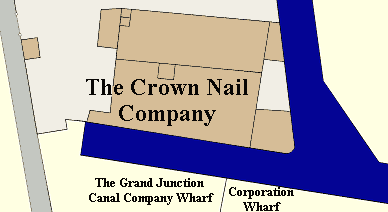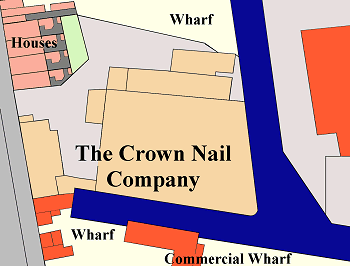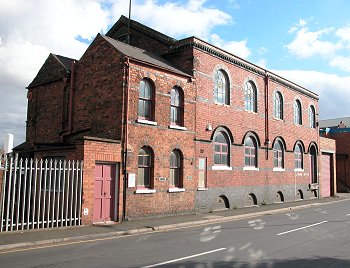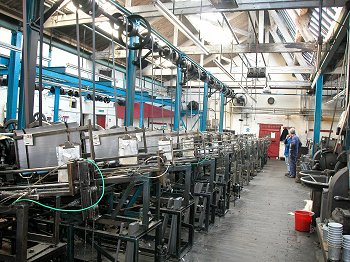|
The Crown Nail Company
The company was established in
about 1850, the same date as the oldest building on
the site, and called the Crown Nail & Stamping
Company. By 1884 the name had changed to the Crown
Nail Company. Until the early 1950s the company was
owned by the Lloyd Family and it is believed that
they were the founders.
In the early years the company
was run by John Lloyd and it seems that his wife
Rose Lloyd, a rather strict and domineering woman,
took over at a later date. She had two sons, Jack
and Harry who went on to run the business for many
years. |
|

The works in 1871. |
Harry Lloyd ran the office and his brother Jack,
an exceptional engineer, ran the factory.
The company produced cut nails until about 1910
when nail production ended until 1986.
From then on blued tacks were produced in large
quantities and sold to many countries throughout the
world. |
| Many of the tack machines were designed and
built in-house and always ran from overhead line
shafting.
Their machines were very advanced and kept the
company at the forefront of the industry.
A special bluing machine was also designed and
built at the works to blue the tacks. |

The works in 1901. |
|

The office and warehouse
building in Commercial Road. |
Under the Lloyd brothers the business was very
profitable, but by the 1950s they were both well
into their 70s and decided that it was time to call
it a day.
Late in 1953 the company was purchased by the
Somerville family, who ran J. & W. Somerville
Limited, Caledonia Nail Works, St. Ninians,
Stirling.
In the early 1970s there was a lot of competition
amongst tack manufacturers and prices fell. |
| In order to cut production costs and keep ahead
of the field Dennis Somerville decided to automate
the tack machines, so reducing the number of people
that were required to feed them.
There were no commercially available automatic
feeds on the market and so the only solution was to
design and build an entirely new auto-feeding
system.
The end result was a cleverly designed,
pneumatically operated machine that had an upright
magazine holding between 100 and 150 strips of
steel. |

The tack shop showing some of
the autofeeds. |
| They were automatically fed into the tack
machine and allowed a girl to feed fifteen machines
instead of five. |
|

A large nail machine and bowl
feed. |
In 1986 nail production
returned to the Commercial Road site using modern
presses to cut the nails which were traditionally
made on nail machines. This was the first time that
nails had been made in this way. It resulted in a
more consistent and cleaner product than the
traditional variety. Many of the traditional
manufacturers soon began to distribute Crown Nail’s
products in preference to their own.
In the beginning there were 5
presses, all of which were hand-fed.
Within a short time very clever
bowl feeds were developed which automatically
oriented the blanks in the right direction to be
loaded into the magazine that fed the press. Many
types of nails were produced, including cut floor
brads and cut clasp nails. |
|
The company had become the last surviving
tack manufacturer in the country, but in 2003 the decision was
taken to end production and so the works closed in December of
that year.
| To read the full story
about the Crown Nail Company visit the
display in the Museum's Engineering
Hall |
 |
| |
|
|
 |
Return to the Canals
and Industry Menu |
|